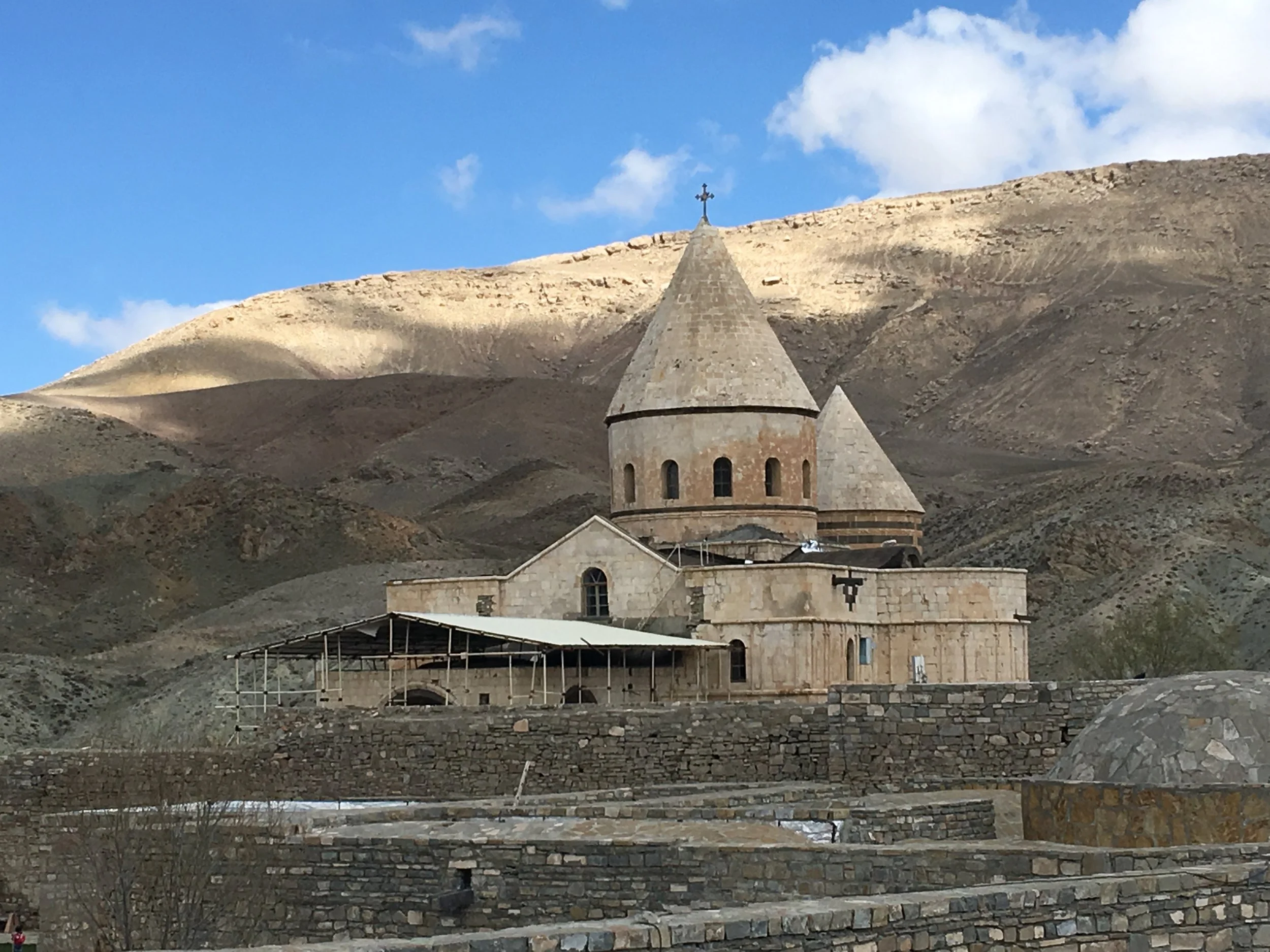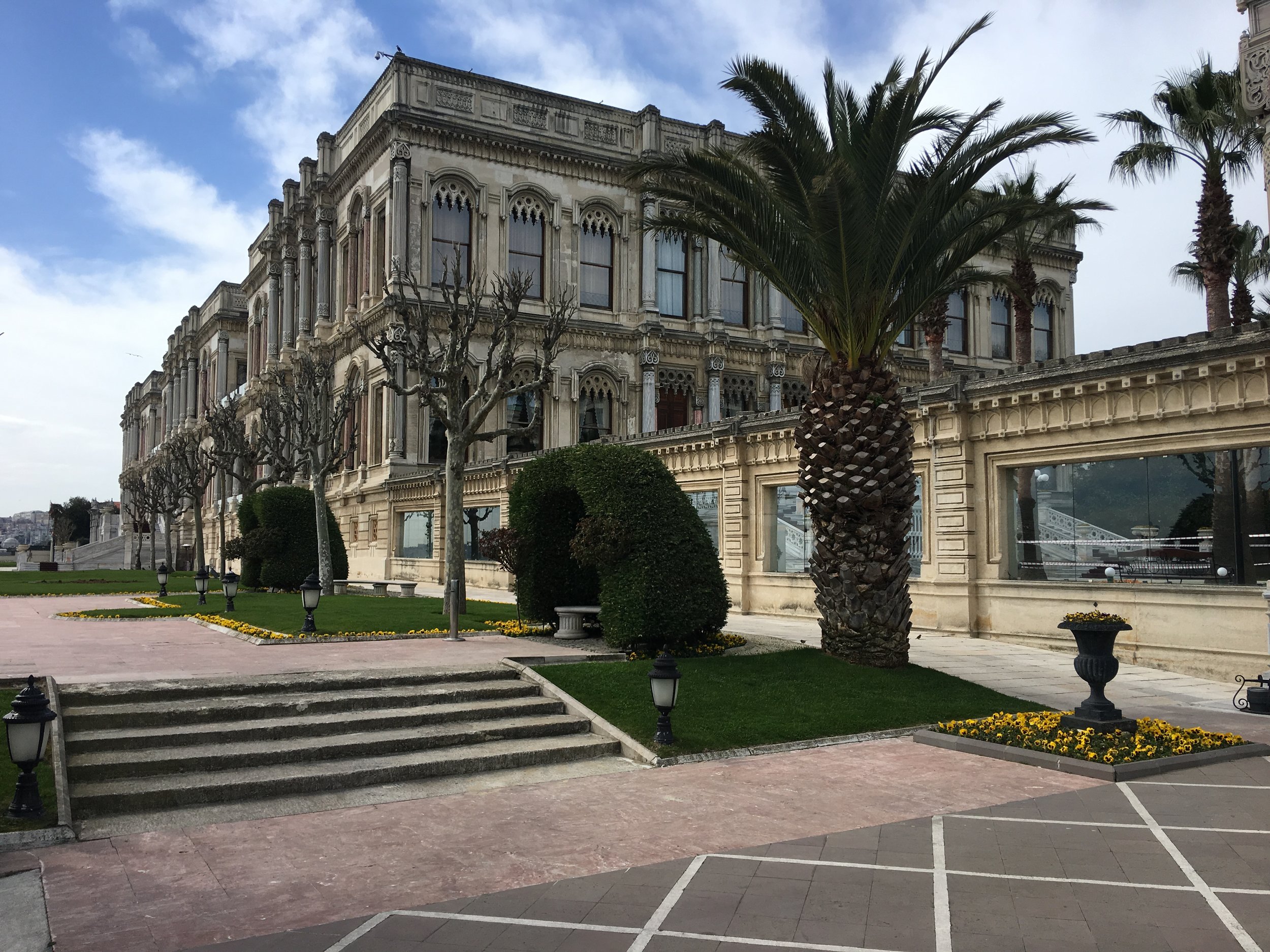Iran 1 - Arriving in Iran
We entered Iran 1st April and because we are British, we are obliged to take a guide and to stay in hotels as we explore Iran. Indeed the process of applying for visas is less than straightforward and we were assisted in this process by Pars, the Iranian travel agency which we had selected to accompany us in Iran. Their representative, Reza, our guide, arrived at the border in a calm reassuring way, and directed us to the small offices near the border, once we were through, to sort out insurance documents for the car and to exchange dollars with money changers who were wandering around with bucket loads of Iranian cash. The only thing we could not get were data SIM cards. At this point I thought it was just a matter of time.
By now I had my orange scarf wrapped around my head and my arms suitably covered with a jacket.
Reza, our young Irànian guide, leapt into the back of the car, where he was to spend many of his days as we criss-crossed Iran in the increasingly balmy weather. Our Sat Nav had just stopped working not having Iranian maps, and with some trepidation, we had shifted to MapsME on the Samsung tablet. And between Reza and MapsME we were off, firstly to Saint Thaddeus Monastery.
Saint Thaddeus Monastery, Armenian 4th Century Church and the first of many mountains
It was a bit surprising that the first port of call in Iran, was a Church. The site has Unesco World Heritage Status and is located in the North East of the Chaldoran Plain, in the mountains of West Azerbaijan, not far from Tabriz. References to the site certainly appear in written texts since 1243. It was apparently severely damaged by an earthquake in the early 14th Century, but opened its doors to pilgrims again in 1328. With the outbreak of wars between Iran and Russia in 1827, many Armenian Christians settled in villages near the Monastery fled to neighbouring countries and a further wave of Armenian emigration followed Ottoman skirmishes in the area at the end of WW1. Such is its provenance, that each year in July thousands of Armenians come to celebrate mass in the church, which is claimed to be the first actual Monastery in Christendom. We had fun looking at the statues around the outside walls and finding amongst them St George and the dragon!
The stonework was delightful and the whole site was in a beautiful remote setting in the middle of nowhere. Rather oddly, there were a dozen Red Crescent tents erected adjacent to the site, selling drinks or accommodating kebab sellers. A very basic kebab was had for lunch and cooked on charcoal outdoors, rolled up in flat bread and swallowed down with the inevitable cup of chai.
We arrived later in Tabriz and were billeted in a very basic hotel in downtown Tabriz, in a room with 3 narrow single beds. It was rather too late to see the Mosque and the renowned spice Bazaar was in any event closed because it was a public holiday. It was our first taste of Iranian town traffic, which was deceptively manageable!
Our second day, was to be a very long one travelling to Zanjan and we were offered, and accepted, a detour up into the mountains, to see another stunning site by the name of Takht e Suleyman.
Before we get to this site, we passed many thousands of picnicking families on the road side, particularly clustered around any trees or streams and in addition we were perplexed by the number of tufts of fresh looking grass casually sitting in the road in a haphazard sort of way. Our guide explained that it was National Nature day, which was a Bank Holiday and also that it was during the school holidays around Iranian New Year. He explained it all and I do think this is worth sharing with you all as it is a tiny bit weird.
So, the Iranian people were celebrating New Year holidays (Nowroz) and National Nature Day. Children get two weeks off school and the whole country picnics on every patch of grass, or in some cases, dust, that they can reach. Cars crammed full of families with picnics surrounded us on all sides and most of them had a turf of grass either on the bonnet of the car, or on the roof or rear parcel shelf.
Needless to say, quite a high proportion of these small turfs ended up on the road and it would not be an exaggeration to say that we saw hundreds on that day. It turns out that on one day of the year, Iranian families travel with a turf on their cars on route to a family picnic and it happened to be the day that we were there. The story goes that as part of the New Year Celebrations families assemble at least 7 items starting with the letter S in Persian and confusingly grass is one of them. The grass on the bonnet must be a bit of traditional national humour. There are tableaux, posters, sort of little shrines everywhere displaying these items, which include an apple, garlic, coins and various herbs. Confusingly there are other things too in the mix, which are like Goldfish and decorated eggs.
So the explanation we were given was that taken together they were all related to regeneration, Fertility, Abundance and Wealth. Individually they represent as follows:
Apple: Symbol of Health
Senjed (herb): Wisdom and New Birth
Vinegar: Surrender and Satisfaction
Samanu: Power and Bravery
Somaq: Patience and Tolerance and Life Stimulating
Garlic: Stimulation
Other items include - Mirror, Goldfish, gold coins, the Quran, Decorated Eggs.
So we are seeing Iranians as fun-loving picnickers, who spend time with their families in the open air, cooking barbeques and playing with their children, who will stop almost anywhere that takes their fancy, taking their cars off road directly from dual carraige ways. It looked a lot of fun and meant that the roads were full of people heading out for their big day.
We had started driving at 9am, stopping briefly for another cheap Kebab in a town, famed for its Kebabs, at midday and arriving at Takht -e-Suleyman at nearly 4pm which involved Jim driving for some 3-4 hours along small mountaineous roads, with stunning scenary, but tiring road conditions.
But arriving at the site was seriously striking. Again, somehow, Iran has not only this amazing monument, but the setting is out of this world, surrounded by snow capped peaks. The site is an extinct volcano rim with an artesian lake at its centre.
The car park was full of Iranians visiting and picnicking. Many of the women were dressed very brightly and many of the men were wearing baggy trousers, hats and high waisted belts over their shirts. These people were ethnic Kurds and they were there in family groups in abundance. Now we realised that many of the picnicking families with their bright outfits in this area of East and West Azerbaijan were Kurds.
The Takht-e-Suleyman complex is actually a Zoroastrian Fire temple. The volcano and lake symbolised fire and water. The cunning Iranians, realising that their new Muslim rulers were likely to destroy a Zoroastrian temple, told them the complex was actually an Islamic shrine. As a result the temple has survived and is considered by UNESCO to be the principal Zoroastrian temple.
Although I was very covered up with a long grey dress and scarf, we obviously did not blend in as effectively as we thought. Children wanted selfies, women wanted to be photographed with us and whole family groups approached us for photographs. We were struck by how welcoming people were. Welcome to our country. There were invitations to people's homes. Requests for contact details etc
After spending nearly an hour at the site we had still another 3 hours of seriously mountaineous driving to get to Zinjan. For the first time the car showed its limitations. Being fully loaded, and with a guide in the rear, the car was finding the relentless passes, one after another a bit taxing, as was its driver!
Arriving in Zanjan, for me, was probably a bit of a low point. We were very tired. The hotel room was drab and poor. Two small single sheets on a double bed. For the first time, I thought about my friend Blanca Fernandez on her bike and her unbelievable resilence. And I just went to sleep and reckoned tomorrow is another day.
Sultaniyeh Dome
Next day, on our way to Teheran, outside Zanjan, we stopped at the Sultaniyeh Dome, a blue domed former Mosque which was also a Unesco Heritage Site. It dated back to 1313 AD when it was completed and is remarkable for the size of its dome, being 48.5 meters high and over 25 meters across. It had been beautifully restored and during the restoration, removal of render revealed really colourful ceramic tiles which had been tastefully uncovered.
Jim & Reza inspecting ties
We had a less taxing schedule that day and it did not take much to persuade me to take tea in a beautiful underground restaurant before we took to the road again. Tea arrived with dates and sweets, then it was only a short hop to remaining put to take an early lunch, sitting on the cool carpetted dining niches. We had a much needed restful time in this underground cafe/restaurant before the last stretch to Teheran.
What I omitted to mention was that prior to the Sultaniyeh Dome, I heard a thud from the car roof and pulled over to investigate. The luggage straps had pinged free and the spare tyre had come completely unattached and had sumersaulted on the roof and was lying upside down, but remarkably still aloft. You may smile at the sight of me being pulled up onto the roof in scarf and long skirt by Jim and Reza at the side of the dual carraigeway. I am not sure he quite knew how to take it, but he helped us to strap eveything back into place and we have photos!
The next installment starts in Teheran.












































